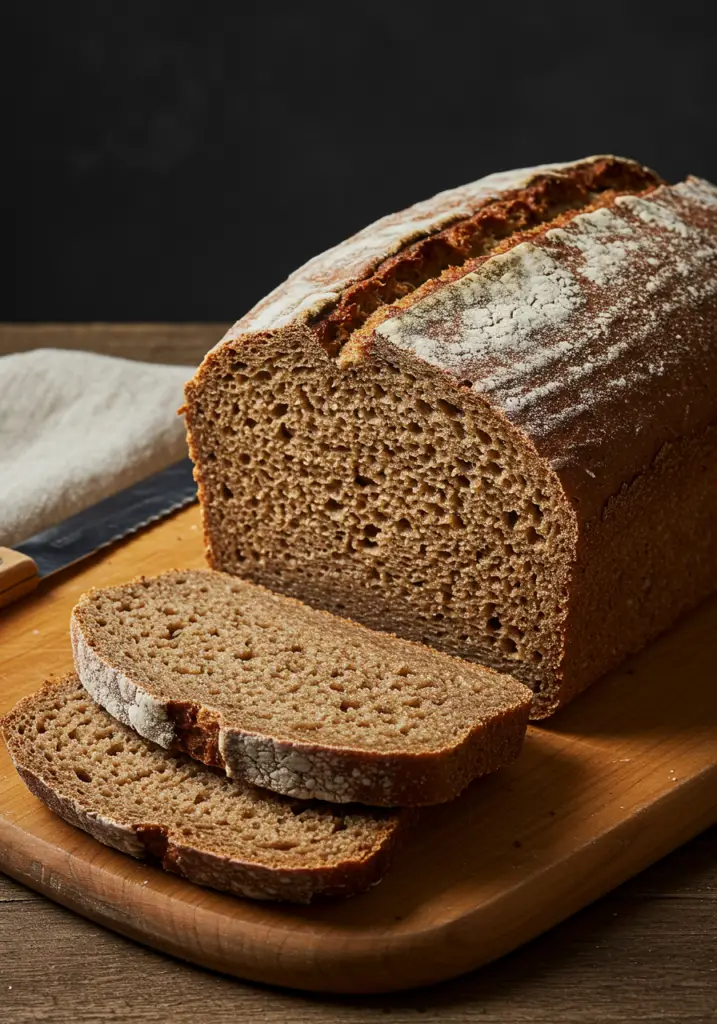German Rye Bread, known as Roggenbrot, is a hearty, robust loaf that holds a special place in traditional German baking. Made with a mix of rye and wheat flour, it has a dense texture, earthy flavor, and a beautifully crisp crust. This bread is perfect for open-faced sandwiches, charcuterie boards, or simply served warm with a pat of butter. It’s a rustic, wholesome option that’s packed with nutrition and flavor.
Want recipes like this delivered straight to your inbox? Subscribe now to get the latest culinary creations you’ll love.
Why You’ll Love This Recipe
Old-World Flavor – Deep, nutty, and slightly tangy taste thanks to rye flour and fermentation.
Filling & Nutritious – High in fiber, low in fat, and keeps you full longer.
No-Fuss – Requires minimal kneading, making it great for beginners.
Perfect for Meal Prep – Keeps fresh for days and freezes beautifully.
Authentically German – A bread that connects you to centuries of baking tradition.
Ingredients You’ll Need
For the Preferment (Sponge):
- 1 cup rye flour
- ½ cup lukewarm water
- ¼ tsp instant dry yeast
For the Dough:
- All of the preferment
- 2 cups rye flour
- 1½ cups bread flour (or all-purpose flour)
- 1¼ cups warm water
- 1½ tsp salt
- 1 tsp sugar or honey
- 1 tsp caraway seeds (optional, traditional addition)
- 1 tsp instant dry yeast
For Dusting (Optional):
- Light rye flour or all-purpose flour
- Additional caraway seeds
Tools You’ll Need
- Large mixing bowl
- Dough scraper or wooden spoon
- Loaf pan or baking sheet
- Kitchen towel or plastic wrap
- Sharp knife or bread lame
- Cooling rack
Step-by-Step Instructions
Step 1: Make the Preferment (Sponge)
- In a medium bowl, mix 1 cup rye flour, ½ cup lukewarm water, and ¼ tsp yeast.
- Stir until a thick paste forms. Cover loosely and let sit at room temperature for 12 to 16 hours.
- The preferment should become bubbly and give off a slightly sour smell—this means it’s ready.
Step 2: Mix the Dough
- In a large bowl, combine the preferment with 2 cups rye flour and 1½ cups bread flour.
- Add salt, sugar or honey, caraway seeds (if using), and the remaining 1 tsp yeast.
- Gradually pour in 1¼ cups warm water and mix until the dough comes together into a sticky, thick mass.
- Rye dough will be stickier than wheat dough—this is normal.
Step 3: First Rise
- Cover the dough with a towel or plastic wrap.
- Let it rise in a warm place for 1 to 1½ hours, until puffed. It may not double in size but should feel soft and airy.
Step 4: Shape the Loaf
- Lightly flour your hands and a work surface.
- Turn out the dough and gently shape it into a loaf or round boule. Avoid kneading too much.
- Place the shaped dough into a greased loaf pan or onto a parchment-lined baking sheet.
- Lightly dust the top with flour and sprinkle with caraway seeds if desired.
Step 5: Final Proof
- Cover the shaped dough with a towel and let rise again for 45–60 minutes.
- It should rise just slightly and feel airy to the touch.
Step 6: Bake the Bread
- Preheat your oven to 425°F (220°C). Place a metal tray with hot water on the bottom rack to create steam.
- Use a sharp knife or bread lame to score the top of the loaf (this helps with expansion).
- Bake for 40–45 minutes, until the crust is deep brown and the loaf sounds hollow when tapped.
- Remove from the oven and cool completely on a wire rack before slicing.
Tips for Perfect German Rye Bread
Use Steam – This creates a crisp crust and improves oven spring.
Avoid Overmixing – Rye dough is delicate and doesn’t require much kneading.
Let It Cool Fully – Cutting into hot rye bread can ruin the texture.
Flavor Improves with Time – It’s even better the next day!
Keep It Moist – Wrap in a clean kitchen towel to maintain softness.
Serving Suggestions
Open-Faced Sandwiches – Top with cream cheese, cucumbers, or sliced beef.
Breakfast Toast – Serve with butter, honey, or jam.
Soup Side – Great with hearty stews, lentil soup, or cabbage dishes.
Snack Plate – Pair with cheese, olives, and pickled vegetables.
How to Store & Reheat
Storing:
- Room Temperature: Keep wrapped in a towel or bread bag for up to 5 days.
- Freezer: Slice and freeze in a sealed bag for up to 2 months.
Reheating:
- Toaster: Perfect for individual slices.
- Oven: Wrap in foil and warm at 300°F (150°C) for 10–12 minutes.
Frequently Asked Questions
1. Why is my dough so sticky?
Rye flour absorbs water differently than wheat. It creates a sticky, tacky dough—totally normal.
2. Can I use only rye flour?
Yes, but expect a much denser texture. Mixing with wheat or bread flour improves structure and rise.
3. Is it okay to skip the caraway seeds?
Absolutely. Caraway is traditional but not required. You can also try fennel or coriander seeds for variation.
4. Can I make this bread with a sourdough starter?
Yes! Replace the preferment with your sourdough starter and skip the additional yeast.
Final Thoughts
German Rye Bread (Roggenbrot) brings an old-world charm and depth of flavor that few breads can match. It’s healthy, hearty, and deeply satisfying—perfect for breakfast, lunch, or as a simple snack. Once you make this bread from scratch, it’ll become a regular in your baking rotation.
Bake it once and enjoy the rich, rustic tradition of German baking in every slice. Share your creations with us, and don’t forget to leave a comment!
Preparation Time: 20 minutes (plus rising time)
Cooking Time: 45 minutes
Cuisine: German
Nutritional Information (Per Serving):
Calories: 190 | Protein: 6g | Carbohydrates: 36g | Fat: 1g | Fiber: 4g | Sodium: 300mg

German Rye Bread (Roggenbrot)
- Prep Time: 20 minutes (plus rising time)
- Cook Time: 45 minutes
- Total Time: 1 hour 5 minutes
- Cuisine: German
Description
German Rye Bread, known as Roggenbrot, is a hearty, robust loaf that holds a special place in traditional German baking. Made with a mix of rye and wheat flour, it has a dense texture, earthy flavor, and a beautifully crisp crust. This bread is perfect for open-faced sandwiches, charcuterie boards, or simply served warm with a pat of butter. It’s a rustic, wholesome option that’s packed with nutrition and flavor.
Want recipes like this delivered straight to your inbox? Subscribe now to get the latest culinary creations you’ll love.
Ingredients
For the Preferment (Sponge):
-
1 cup rye flour
-
½ cup lukewarm water
-
¼ tsp instant dry yeast
For the Dough:
-
All of the preferment
-
2 cups rye flour
-
1½ cups bread flour (or all-purpose flour)
-
1¼ cups warm water
-
1½ tsp salt
-
1 tsp sugar or honey
-
1 tsp caraway seeds (optional, traditional addition)
-
1 tsp instant dry yeast
For Dusting (Optional):
-
Light rye flour or all-purpose flour
-
Additional caraway seeds
Instructions
Step 1: Make the Preferment (Sponge)
-
In a medium bowl, mix 1 cup rye flour, ½ cup lukewarm water, and ¼ tsp yeast.
-
Stir until a thick paste forms. Cover loosely and let sit at room temperature for 12 to 16 hours.
-
The preferment should become bubbly and give off a slightly sour smell—this means it’s ready.
Step 2: Mix the Dough
-
In a large bowl, combine the preferment with 2 cups rye flour and 1½ cups bread flour.
-
Add salt, sugar or honey, caraway seeds (if using), and the remaining 1 tsp yeast.
-
Gradually pour in 1¼ cups warm water and mix until the dough comes together into a sticky, thick mass.
-
Rye dough will be stickier than wheat dough—this is normal.
Step 3: First Rise
-
Cover the dough with a towel or plastic wrap.
-
Let it rise in a warm place for 1 to 1½ hours, until puffed. It may not double in size but should feel soft and airy.
Step 4: Shape the Loaf
-
Lightly flour your hands and a work surface.
-
Turn out the dough and gently shape it into a loaf or round boule. Avoid kneading too much.
-
Place the shaped dough into a greased loaf pan or onto a parchment-lined baking sheet.
-
Lightly dust the top with flour and sprinkle with caraway seeds if desired.
Step 5: Final Proof
-
Cover the shaped dough with a towel and let rise again for 45–60 minutes.
-
It should rise just slightly and feel airy to the touch.
Step 6: Bake the Bread
-
Preheat your oven to 425°F (220°C). Place a metal tray with hot water on the bottom rack to create steam.
-
Use a sharp knife or bread lame to score the top of the loaf (this helps with expansion).
-
Bake for 40–45 minutes, until the crust is deep brown and the loaf sounds hollow when tapped.
-
Remove from the oven and cool completely on a wire rack before slicing.
Notes
Use Steam – This creates a crisp crust and improves oven spring.
Avoid Overmixing – Rye dough is delicate and doesn’t require much kneading.
Let It Cool Fully – Cutting into hot rye bread can ruin the texture.
Flavor Improves with Time – It’s even better the next day!
Keep It Moist – Wrap in a clean kitchen towel to maintain softness.



